Yesterday morning, as I was recovering from working on stage crew for the 34th Reggae on the River (fundraiser for the non profit, the Mateel Community Center), I noticed on social media that there was an M 6.9 earthquake in Lombok, Indonesia. This is sad because of the likelihood for casualties and economic damage in this region.
However, it is interesting because the earthquake sequence from last week (with a largest earthquake with a magnitude of M 6.4) were all foreshocks to this M 6.9. Now, technically, these were not really foreshocks. The M 6.4 has an hypocentral (3-D location) depth of ~6 km and the M 6.9 has an hypocentral depth of ~31 km. These earthquakes are not on the same fault, so I would interpret that the M 6.9 was triggered by the sequence from last week due to static coulomb changes in stress on the fault that ruptured. Given the large difference in depths, the uncertainty for these depths is probably not sufficient to state that they may be on the same fault (i.e. these depths are sufficiently different that this difference is larger than the uncertainty of their locations).
I present a more comprehensive analysis of the tectonics of this region in my earthquake report for the M 6.4 earthquake here. I especially address the historic seismicity of the region there. This M 6.9 may have been on the Flores thrust system, while the earthquakes from last week were on the imbricate thrust faults overlying the Flores Thrust. See the map from Silver et al. (1986) below. I include the same maps as in my original report, but after those, I include the figures from Koulani et al. (2016) (the paper is available on researchgate).
UPDATE 2018.08.08
Based on Eric Fielding and JD Dianala’s interpretation of the InSAR data, the M 6.4 and M 6.9 earthquakes could possibly have a similar hypocentral depth. See Social Media update below.
Find out more about InSAR (Interferometric Synthetic Aperture Radar) here.
In addition, as Dr. Anthony Lomax pointed out, the USGS depth uncertainty is large enough for these earthquakes that they may be along the same fault.
Dr. Fielding uses the InSAR data (see update below) to interpret the fault geometry.
UPDATE 2018.08.12
People have been asking me if we might expect another large or larger earthquake in this region. So, here is what I have told them:
- It is difficult to say if there will be a larger or another large earthquake or not.
- Based upon historic seismicity, the M 6.9 is probably the mainshock in this sequence. But the historic record is short (100 yrs +-), so may not be a perfect sample of what could happen.
- The M 6.9 probably ruptured the Flores thrust fault, a back thrust to the subduction zone.
- There is probably a small chance that the Flores thrust fault (east west fault dipping to the south) to the east and west of the M 6.9 has an increased amount of stress imparted upon it from the M 6.9 (small amount, so if the fault was almost ready to go, this change might make it go). but this is a small possibility (but still possible). (i.e. Bali).
- There is also a small chance that the subduction zone (south of the islands, dipping to the north) also has an increased amount of stress from this M 6.9 earthquake. but this is probably less likely than the other example (due to the distance between the M .6.9 and the subduction zone fault.
- Though there will probably be earthquakes up to M 5 or mid M 5 as aftershocks… and as time passes, the chance of a larger earthquake diminish to the background risk of such an earthquake. by the time it is Sept through Dec, we will probably have passed the increased risk due to the M 6.9 sequence.
- But we must always remember, we cannot absolutely know what will happen. our observational history is only a few centuries and seismometers are only a century old (and modern ones, with a global network, maybe 50 years). so it is challenging to think that we know about how this region (or any region) behaves tectonically.
UPDATE 2018.08.19
Below is my interpretive poster for this earthquake
I plot the seismicity from the past month, with color representing depth and diameter representing magnitude (see legend). I include earthquake epicenters from 1918-2018 with magnitudes M ≥ 6.0 in one version.
I plot the USGS fault plane solutions (moment tensors in blue and focal mechanisms in orange), possibly in addition to some relevant historic earthquakes.
- I placed a moment tensor / focal mechanism legend on the poster. There is more material from the USGS web sites about moment tensors and focal mechanisms (the beach ball symbols). Both moment tensors and focal mechanisms are solutions to seismologic data that reveal two possible interpretations for fault orientation and sense of motion. One must use other information, like the regional tectonics, to interpret which of the two possibilities is more likely.
- I also include the shaking intensity contours on the map. These use the Modified Mercalli Intensity Scale (MMI; see the legend on the map). This is based upon a computer model estimate of ground motions, different from the “Did You Feel It?” estimate of ground motions that is actually based on real observations. The MMI is a qualitative measure of shaking intensity. More on the MMI scale can be found here and here. This is based upon a computer model estimate of ground motions, different from the “Did You Feel It?” estimate of ground motions that is actually based on real observations.
- I include the slab contours plotted (Hayes et al., 2012), which are contours that represent the depth to the subduction zone fault. These are mostly based upon seismicity. The depths of the earthquakes have considerable error and do not all occur along the subduction zone faults, so these slab contours are simply the best estimate for the location of the fault.
- In the map below, I include a transparent overlay of the magnetic anomaly data from EMAG2 (Meyer et al., 2017). As oceanic crust is formed, it inherits the magnetic field at the time. At different points through time, the magnetic polarity (north vs. south) flips, the north pole becomes the south pole. These changes in polarity can be seen when measuring the magnetic field above oceanic plates. This is one of the fundamental evidences for plate spreading at oceanic spreading ridges (like the Gorda rise).
- Regions with magnetic fields aligned like today’s magnetic polarity are colored red in the EMAG2 data, while reversed polarity regions are colored blue. Regions of intermediate magnetic field are colored light purple.
- We can see the roughly east-west trends of these red and blue stripes. These lines are parallel to the ocean spreading ridges from where they were formed. The stripes disappear at the subduction zone because the oceanic crust with these anomalies is diving deep beneath the Sunda plate (part of Eurasia), so the magnetic anomalies from the overlying Sunda plate mask the evidence for the Australia plate.
Magnetic Anomalies
- In the upper right corner is a low angle oblique view of the Sunda subduction zone beneath Java, Bali, Lombok, and Sumbawa (from Earth Observatory Singapore). I place a blue star in the general location of today’s earthquake’s epicenter (as for all figures here). The India-Australia plate is subducting northwards beneath the Sunda plate (part of the Eurasia plate).
- In the upper left corner is a map from Koulali et al. (2016) that presents a plate tectonic map for this region. They present earthquake mechanisms for some historic earthquakes. These authors favor the interpretation that the Flores thrust fault system extends to eastern Java.
- To the right of the Koulali et al. (2016) map is a cross section of seismicity presented by Hengresh and Whitney (2016). These authors argue for a north vergent Flores thrust in this region, though most of their work was on the subduction/collision zone.
- In the lower right corner is another Koulali et al. (2016) map that shows the relative amount of motion across these plate boundary fault systems as modeled in their analysis. Based on their modeling, there is about 10-20 mm/yr of strain accumulating on the Flores thrust system north of Lombok, Indonesia.
- In the lower left corner is a Koulali et al. (2016) that shows their estimate of this strain accumulation (via fault slip deficit) for the Flores thrust fault.
I include some inset figures.
Other Report Pages
Some Relevant Discussion and Figures
- Below is a map showing historic seismicity (Jones et al., 2014). Cross sections B-B’ and C-C’ are shown. The seismicity for the cross sections below are sourced from within each respective rectangle.
- Here are the seismcity cross sections.
- Here is the map from McCaffrey and Nabelek (1987). They used seismic reflection profiles, gravity modeling along these profiles, seismicity, and earthquake source mechanism analyses to support their interpretations of the structures in this region.
Tectonic and geographic map of the eastern Sunda arc and vicinity. Active volcanoes are represented by triangles, and bathymetric contours are in kilometers. Thrust faults are shown with teeth on the upper plate. The dashed box encloses the study area.
- Here is the Audley (2011) cross section showing how the backthrust relates to the subduction zone beneath Timor. I include their figure caption in blockquote below.
Cartoon cross section of Timor today, (cf. Richardson & Blundell 1996, their BIRPS figs 3b, 4b & 7; and their fig. 6 gravity model 2 after Woodside et al. 1989; and Snyder et al. 1996 their fig. 6a). Dimensions of the filled 40 km deep present-day Timor Tectonic Collision Zone are based on BIRPS seismic, earthquake seismicity and gravity data all re-interpreted here from Richardson & Blundell (1996) and from Snyder et al. (1996). NB. The Bobonaro Melange, its broken formation and other facies are not indicated, but they are included with the Gondwana mega-sequence. Note defunct Banda Trench, now the Timor TCZ, filled with Australian continental crust and Asian nappes that occupy all space between Wetar Suture and the 2–3 km deep deformation front north of the axis of the Timor Trough. Note the much younger decollement D5 used exactly the same part of the Jurassic lithology of the Gondwana mega-sequence in the older D1 decollement that produced what appears to be much stronger deformation.
- This are the seismicity cross sections from Hangesh and Whitney (2016). These are shown to compare the subduction zone offshore of Java and the collision zone in the Timor region.
Comparison of hypocentral profiles across the (a) Java subduction zone and (b) Timor collision zone (paleo-Banda trench). Catalog compiled from multiple reporting agencies listed in Table 1. Events of Mw>4.0 are shown for period 1815 to 2015.
- Here is a map of the same general area from Silver et al. (1986), used here to locate the following large scale map.
Location of SeaMARC II survey (Plate 1 and Figures 2) and geographic features discussed in text. Triangles on upper plates of thrust zones.
- This is the large scale map showing the detailed thrust fault mapping (Silver et al., 1986).
Bathymetry, faults, and mud diapirs of the central Flores thrust zone, based on interpretation of SeaMARC II data and seismic reflection profiles. Shown also are locations (circled numbers) of all seismic profiles. Mud diapirs are solid black. Triangles on upper plates of thrust faults.
Bathymetry, faults, and mud diapirs of the central Flores thrust zone, based on interpretation of SeaMARC II data and seismic reflection profiles. Shown also are locations (circled numbers) of all seismic profiles. Mud diapirs are solid black. Triangles on upper plates of thrust faults.
- Here is the tectonic map from Hangesh and Whitney (2016).
Illustration of major tectonic elements in triple junction geometry: tectonic features labeled per Figure 1; seismicity from ISC-GEM catalog [Storchak et al., 2013]; faults in Savu basin from Rigg and Hall [2011] and Harris et al. [2009]. Purple line is edge of Australian continental basement and fore arc [Rigg and Hall, 2011]. Abbreviations: AR = Ashmore Reef; SR = Scott Reef; RS = Rowley Shoals; TCZ = Timor Collision Zone; ST = Savu thrust; SB = Savu Basin; TT = Timor thrust; WT =Wetar thrust; WASZ = Western Australia Shear Zone. Open arrows indicate relative direction of motion; solid arrows direction of vergence.
- Here are some focal mechanisms from earthquakes in the region from Hangesh and Whitney (2016). Symbol color represents depth.
(a) Focal mechanism solutions for the study region. The focal mechanisms are classified based on depth intervals to illustrate the style of faulting within the different structural domains. Note (b) sinistral reverse motion along Timor trough, (c) subduction related pattern along Java trench, and dextral solutions along the western Australia extended margin (Figure 4a) north of 20°S. Centroid moment tensor (CMT) solutions [Dziewonski et al., 1981] are from the CMT project [Ekström et al., 2012; http://www.globalcmt.org/CMTcite.html] for events of Mw>5.0 for the period 1976 onward.
- Here is a figure showing the regional geodetic motions (Bock et al., 2003). I include their figure caption below as a blockquote.
Topographic and tectonic map of the Indonesian archipelago and surrounding region. Labeled, shaded arrows show motion (NUVEL-1A model) of the first-named tectonic plate relative to the second. Solid arrows are velocity vectors derived from GPS surveys from 1991 through 2001, in ITRF2000. For clarity, only a few of the vectors for Sumatra are included. The detailed velocity field for Sumatra is shown in Figure 5. Velocity vector ellipses indicate 2-D 95% confidence levels based on the formal (white noise only) uncertainty estimates. NGT, New Guinea Trench; NST, North Sulawesi Trench; SF, Sumatran Fault; TAF, Tarera-Aiduna Fault. Bathymetry [Smith and Sandwell, 1997] in this and all subsequent figures contoured at 2 km intervals.
- This map from Hangesh and Whitney (2016) shows the GPS velocities in this region. Note the termination of the Flores thrust and the north-northeast striking (oriented) cross fault between Lombok and Sumbawa.
GPS velocities of Sunda and Banda arc region. Large black and grey arrow shows motion of Australia relative to Eurasia [DeMets et al., 1994]. Thin black arrows show GPS velocities of Sunda and Banda arc regions relative to Australia [Nugroho et al., 2009]. Seismicity from ISC-GEM catalog [Storchak et al., 2013]. Note reduction of station velocities from west to east indicating progressive coupling of the Banda arc to the Australian plate compared to the area along the Sunda arc.
- Below are the 4 figures from Koulani et al., 2016. First is the plate tectonic map. I include their figure captions in block quote.
- This figure shows their estimates for plate motion relative velocities as derived from GPS data, constrained by the fault geometry in their block modeling.
- This figure shows their estimates of slip rate deficit along all the plate boundary faults in this region.
- Here is their figure that shows the slip deficit along the plate boundary faults.
Seismotectonic setting of the Sunda-Banda arc-continent collision, East Indonesia. Major faults (thick black lines) [Hamilton, 1979]. Topography and bathymetry are from Shuttle Radar Topography Mission (http://topex.ucsd.edu/www_html/srtm30_plus.html). Focal mechanisms are from the Global Centroid Moment Tensor. Blue mechanisms correspond to earthquakes with Mw>7 (brown transparent ellipses are the corresponding rupture areas for Flores 1992 and Alor 2004 earthquakes), while the green focal mechanism shows the highest magnitude recorded in Sumbawa. Red dots indicate the locations of major historical earthquakes [Musson, 2012].
GPS velocities determined in this study with respect to Sunda Block. Uncertainty ellipses represent 95% confidence level. The inset figure corresponds to the area of the dashed rectangle in the map. Light blue arrows show the velocities for East and West Makassar Blocks.
Relative slip vectors across block boundaries, derived from our best fit model. Arrows show motion of the hanging wall (moving block) relative to the footwall (fixed block) with 95% confidence ellipses. The tails of arrows is located within the “moving” block. Black thick lines show well-defined boundaries we use as active faults in our model and dashed lines show less well-defined boundaries (green : free-slipping boundaries and black: fixed locked faults) . Principal axes of the horizontal strain tensor estimated for the SUMB, EMAK, and EJAV are shown in pink. The thick pink arrow shows the relative motion of Australia with respect to Sunda (AUST/SUND). Abbreviations are Sumba Block (SUMB), West Makassar Block (WMAK), East Makassar Block (EMAK), East Java Block (EJAV), and Timor Block (TIMO). The background seismicity is from the International Seismological Centre catalog with magnitudes ≥5.5 and depths <40 km.
Fault slip rate components: (a) fault normal (extension positive) and (b) fault parallel (right-lateral positive).
UPDATE 2018.08.08
NASA InSAR
- Here is the InSAR result from Eric Fielding at NASA, the files are available here.
- These data are from a change in position between 2018.07.30 and 2018.08.05, so they compare the ground motion of only the M 6.9 earthquake (generally speaking).
- From Dr. Fielding
Deformation of Lombok Island, Indonesia due to 5 August 2018 earthquake shows uplift of northwest corner due to fault slip at depth, measured with #InSAR of Copernicus Sentinel-1 radar images processed by Caltech-JPL ARIA project. Data at https://go.nasa.gov/2OlbxY6
Black contours are 5 cm (2 inches). Copernicus Sentinel-1 data acquired on 30 July and 5 August 2018. White areas where measurement not possible, largely due to dense forests.
Measurements with #InSAR are in direction towards satellite, so not purely vertical or horizontal. Mostly vertical in this case.
My preliminary interpretation is that uplift is due to a north-dipping blind thrust fault that would project to the surface near the “zero” level of the interferogram, but a south-dipping thrust fault is also possible with down-dip end of rupture beneath the “zero” line
Rusi P InSAR
- These two InSAR images allow us to compare ground deformation from these two earthquakes. Rusi P presents these results on twitter here. This tweet is also posted below in the Social Media section.
- This is the analysis for the M 6.4 earthquake. This interferogram is made from SAR data collected on 7/18 and 7/30.
- This is the analysis for the M 6.9 earthquake. This interferogram is made from SAR data collected on 7/30 and 8/05.
Geologic Fundamentals
- For more on the graphical representation of moment tensors and focal mechnisms, check this IRIS video out:
- Here is a fantastic infographic from Frisch et al. (2011). This figure shows some examples of earthquakes in different plate tectonic settings, and what their fault plane solutions are. There is a cross section showing these focal mechanisms for a thrust or reverse earthquake. The upper right corner includes my favorite figure of all time. This shows the first motion (up or down) for each of the four quadrants. This figure also shows how the amplitude of the seismic waves are greatest (generally) in the middle of the quadrant and decrease to zero at the nodal planes (the boundary of each quadrant).
- There are three types of earthquakes, strike-slip, compressional (reverse or thrust, depending upon the dip of the fault), and extensional (normal). Here is are some animations of these three types of earthquake faults. The following three animations are from IRIS.
Strike Slip:
Compressional:
Extensional:
- This is an image from the USGS that shows how, when an oceanic plate moves over a hotspot, the volcanoes formed over the hotspot form a series of volcanoes that increase in age in the direction of plate motion. The presumption is that the hotspot is stable and stays in one location. Torsvik et al. (2017) use various methods to evaluate why this is a false presumption for the Hawaii Hotspot.
- Here is a map from Torsvik et al. (2017) that shows the age of volcanic rocks at different locations along the Hawaii-Emperor Seamount Chain.
A cutaway view along the Hawaiian island chain showing the inferred mantle plume that has fed the Hawaiian hot spot on the overriding Pacific Plate. The geologic ages of the oldest volcano on each island (Ma = millions of years ago) are progressively older to the northwest, consistent with the hot spot model for the origin of the Hawaiian Ridge-Emperor Seamount Chain. (Modified from image of Joel E. Robinson, USGS, in “This Dynamic Planet” map of Simkin and others, 2006.)
Hawaiian-Emperor Chain. White dots are the locations of radiometrically dated seamounts, atolls and islands, based on compilations of Doubrovine et al. and O’Connor et al. Features encircled with larger white circles are discussed in the text and Fig. 2. Marine gravity anomaly map is from Sandwell and Smith.
- M 9.2 Andaman-Sumatra subduction zone 2014 Earthquake Anniversary
- M 9.2 Andaman-Sumatra subduction zone SASZ Fault Deformation
- M 9.2 Andaman-Sumatra subduction zone 2016 Earthquake Anniversary
- 2018.08.05 M 6.9 Lombok, Indonesia
- 2018.07.28 M 6.4 Lombok, Indonesia
- 2017.12.15 M 6.5 Java
- 2017.08.31 M 6.3 Mentawai, Sumatra
- 2017.08.13 M 6.4 Bengkulu, Sumatra, Indonesia
- 2017.05.29 M 6.8 Sulawesi, Indonesia
- 2017.03.14 M 6.0 Sumatra
- 2017.03.01 M 5.5 Banda Sea
- 2016.10.19 M 6.6 Java
- 2016.03.02 M 7.8 Sumatra/Indian Ocean
- 2015.07.22 M 5.8 Andaman Sea
- 2015.11.08 M 6.4 Nicobar Isles
- 2012.04.11 M 8.6 Sumatra outer rise
- 2004.12.26 M 9.2 Andaman-Sumatra subduction zone
Indonesia | Sumatra Earthquake Reports
General Overview
Earthquake Reports
Social Media
Expert warns of strong aftershocks in Indonesia following Lombok quakehttps://t.co/sEJyziJO1b pic.twitter.com/LtwwKLcsF7
— BBC News (World) (@BBCWorld) August 6, 2018
Mw=6.9, SUMBAWA REGION, INDONESIA (Depth: 18 km), 2018/08/05 11:46:34 UTC – Full details here: https://t.co/jws7oFBoaM pic.twitter.com/AtlFwTFCZa
— Earthquakes (@geoscope_ipgp) August 5, 2018
M6.9 #earthquake #Lombok, #Indonesia: High-frequency seismogram (lower; station JAGI on Java ~250km W of epicenter) suggests up to ~50sec of rupture duration. Geoscope and USGS long-period waveform analyses give ~20sec duration.https://t.co/F8EkNdVkfYhttps://t.co/0fVh9lO59J pic.twitter.com/enJn9nYwUF
— Anthony Lomax 🌍🇪🇺 (@ALomaxNet) August 7, 2018
Do you believe in seismic gaps ?!! the location of the Mw 6.9 Lombok earthquake 2018 added to fig1 of our GRL 2016 paper pic.twitter.com/VXHWC7Mzop
— Achraf (@KoulaliAchraf) August 6, 2018
Great @ESA_EO #Sentinel1 coverage of M6.9 #Loloan quake, Indonesia. Automatic @UAFGI #SARVIEWS InSAR 🛰️ data shows significant deformation. Download free InSAR data products for this event @ https://t.co/OfHXvqNlu6.@InSARinfo @Ak_Satellite @NASAEarthData pic.twitter.com/SkQ17k5gAT
— Franz J Meyer (@SARevangelist) August 6, 2018
Watch the waves from the M6.9 #LombokEarthquake roll across the USArray seismic network (https://t.co/RIcNz4bgWq). Red means the ground is going up; blue means down. The waves are too small to be felt but can be detected by these sensitive instruments. https://t.co/SoZMmJHvCU pic.twitter.com/G66CUjeZqE
— IRIS Earthquake Sci (@IRIS_EPO) August 6, 2018
2018-08-05 Mw6.9 Indonesia earthquake interferogram#insar #earthquake pic.twitter.com/al2ahJJ4pJ
— R P (@rusi_p) August 6, 2018
Here are high-frequency estimates of apparent rupture duration for large earthquakes 1992-2012 compared to Global CMT (Lomax & Michelini, 2012).
Much scatter due to different earthquake types, but 50sec is on the high end for M7.https://t.co/po5va0kmlXhttps://t.co/y2FptSd3YU pic.twitter.com/fgg6EGeOPk— Anthony Lomax 🌍🇪🇺 (@ALomaxNet) August 7, 2018
Q: What is the probability that an #earthquake is a foreshock to a larger earthquake?
A: "Worldwide the probability that an earthquake will be followed within 3 days by a large earthquake nearby is somewhere just over 6%." – @USGS https://t.co/pgaXc03xsT— IRIS Earthquake Sci (@IRIS_EPO) August 7, 2018
Here is a coseismic interferogram of the Mw6.9 earthquake in Lombok island on Aug. 5. Analysis of Sentinel-1A/B images with Gamma(R) pic.twitter.com/tlJJT7Lx6i
— 橋本学 (@manabu0131dpri) August 7, 2018
Mechanism & epicenter of today’s M6.9 quake in Lombok, Indonesia, similar to that of M6.4 week earlier (for which map & crosssection of historical seismicity attached), although bit deeper. Event likely did not occur on subduction interface, but on backthrust behind it. pic.twitter.com/2yMPIrwFcX
— Jascha Polet (@CPPGeophysics) August 5, 2018
close-up view on #Lombok #earthquake, also covering #Bali, still expecting extensive damage and fatalities. Be prepared for various (strong) aftershocks. pic.twitter.com/1prVkTzNOr
— CATnews (@CATnewsDE) August 5, 2018
#RT Several major #earthquakes have struck the Indonesian island of #Lombok in the past week. #Indonesia sits along the “Pacific Ring of Fire” where several #tectonicplates collide but there are other unique conditions around Lombok @ConversationUS ➡️ https://t.co/a4a6cCXnxl pic.twitter.com/Ir1YRFijHX
— Raspberry Shake (@raspishake) August 7, 2018
Earthquake: Aug-06 M6.9 Pulau Lombok, Indonesia | depth 31 Km, ~100 people dead. Damage as far away as Bali. Mass evacuation 'chaos' from the Gili "tourist" Islands.#Lombokquake #ahemQUAKEShttps://t.co/b1P3wdq8nd
— aHEMagain ❌ (@aHEM_again) August 6, 2018
#Indonesia’s National Disaster Management Agency released video of thousands of tourists trying to get off #Gili Islands after #Lombokquake. pic.twitter.com/ZXOW1aqpuQ
— Jon Williams (@WilliamsJon) August 6, 2018
All trapped tourists have been evacuated from #Lombok's nearby Gili Meno Island after deadly earthquake, according to Indonesia's Tourism Ministry #Lombokquake pic.twitter.com/I2AofMLe3v
— CGTN (@CGTNOfficial) August 7, 2018
Some of the damage at Teluk Nara bus station #Lombokquake pic.twitter.com/x4EkCLaFxP
— David Lipson (@davidlipson) August 6, 2018
#Lombokquake M 7.0 which struck Lombok, Indonesia on 5 August 2018, caused small tsunamis. Death toll: 82
The earthquake was the main shock following its foreshocks, a nearby M 6.4 earthquake on the morning of 29 July 2018. 91 people confirmed killed ,over 100 confirmed injured. pic.twitter.com/2wFW8FrAgq— Bali Promotion Center💅 (@translatorbali) August 6, 2018
The shoes of those trapped under this collapsed mosque #Lombokquake pic.twitter.com/mKNIAWJz9y
— David Lipson (@davidlipson) August 7, 2018
#Lombokquake: Thousands evacuated after dozens die on #Indonesia island https://t.co/lIXD7vBENe
— Ekanem Etim-Offiong (@akemmapapa) August 6, 2018
Tourists flee Indonesia's Lombok island after earthquake kills 98 #Lombokquake #Indonesia https://t.co/DxFlg7Mch3
— RangerRick ن (@sacreole) August 6, 2018
UPDATE 2018.08.08
There's no scale, and actual modeling would show more precisely, but just comparing the number fringes from the InSAR by @rusi_p , it seems that there shouldn't be a very big difference in the depths of both earthquakes? https://t.co/xM1heCiXyg
— JD Dianala (@geoloJD) August 7, 2018
USGS closest station JAGI is ~250km from epicenter (need stations at distance of approx true depth to resolve depth well) and residuals at nearer stations are very large (>1sec). So event depth is likely very poorly constrained.https://t.co/gU9lOgE4vp pic.twitter.com/g2gsVsgA1s
— Anthony Lomax 🌍🇪🇺 (@ALomaxNet) August 8, 2018
Displacement map for 5 August 2018 M6.9 #Lombok #earthquake from Copernicus Sentinel-1 radar data #InSAR processed by NASA Caltech-JPL ARIA released on @NASAJPL news page https://t.co/YXv2BzVHgu
NASA Disasters data portal https://t.co/v7V1sNFqq4— Eric Fielding (@EricFielding) August 9, 2018
Updated – More details of death and destruction emerge from Lombok after the #IndonesiaEarthQuake . This graphic explains the tragedy https://t.co/MDscEPWc3A
— Reuters Graphics (@ReutersGraphics) August 7, 2018
UPDATE 2018.08.09
Liquifaksi (luquefaction) yaitu tanah yang kaku berubah menjadi gembur dan muncul lumpur akibat tekanan gempa 7 SR terjadi di Desa Selengen Kecamatan Kayangan Lombok Utara. Liquifaksi banyak menyebabkan bangunan roboh karena bangunan berdiri diatas tanah gembur dan pondasi patah. pic.twitter.com/Wfu1NhSkJW
— Sutopo Purwo Nugroho (@Sutopo_PN) August 9, 2018
- Audley-Charles, M.G., 1986. Rates of Neogene and Quaternary tectonic movements in the Southern Banda Arc based on micropalaeontology in: Journal of fhe Geological Society, London, Vol. 143, 1986, pp. 161-175.
- Audley-Charles, M.G., 2011. Tectonic post-collision processes in Timor, Hall, R., Cottam, M. A. &Wilson, M. E. J. (eds) The SE Asian Gateway: History and Tectonics of the Australia–Asia Collision. Geological Society, London, Special Publications, 355, 241–266.
- Baldwin, S.L., Fitzgerald, P.G., and Webb, L.E., 2012. Tectonics of the New Guinea Region in Annu. Rev. Earth Planet. Sci., v. 41, p. 485-520.
- Benz, H.M., Herman, Matthew, Tarr, A.C., Hayes, G.P., Furlong, K.P., Villaseñor, Antonio, Dart, R.L., and Rhea, Susan, 2011. Seismicity of the Earth 1900–2010 New Guinea and vicinity: U.S. Geological Survey Open-File Report 2010–1083-H, scale 1:8,000,000.
- Darman, H., 2012. Seismic Expression of Tectonic Features in the Lesser Sunda Islands, Indonesia in Berita Sedimentologi, Indonesian Journal of Sedimentary Geology, no. 25, po. 16-25.
- Hall, R., 2011. Australia-SE Asia collision: plate tectonics and crustal flow in Geological Society, London, Special Publications 2011; v. 355; p. 75-109 doi: 10.1144/SP355.5
- Hangesh, J. and Whitney, B., 2014. Quaternary Reactivation of Australia’s Western Passive Margin: Inception of a New Plate Boundary? in: 5th International INQUA Meeting on Paleoseismology, Active Tectonics and Archeoseismology (PATA), 21-27 September 2014, Busan, Korea, 4 pp.
- Hayes, G.P., Wald, D.J., and Johnson, R.L., 2012. Slab1.0: A three-dimensional model of global subduction zone geometries in, J. Geophys. Res., 117, B01302, doi:10.1029/2011JB008524
- Jones, E.S., Hayes, G.P., Bernardino, Melissa, Dannemann, F.K., Furlong, K.P., Benz, H.M., and Villaseñor, Antonio, 2014. Seismicity of the Earth 1900–2012 Java and vicinity: U.S. Geological Survey Open-File Report 2010–1083-N, 1 sheet, scale 1:5,000,000, https://dx.doi.org/10.3133/ofr20101083N.
- Koulali, A., S. Susilo, S. McClusky, I. Meilano, P. Cummins, P. Tregoning, G. Lister, J. Efendi, and M. A. Syafi’i, 2016. Crustal strain partitioning and the associated earthquake hazard in the eastern Sunda-Banda Arc in Geophys. Res. Lett., 43, 1943–1949, doi:10.1002/2016GL067941
- McCaffrey, R., and Nabelek, J.L., 1984. The geometry of back arc thrusting along the Eastern Sunda Arc, Indonesia: Constraints from earthquake and gravity data in JGR, Atm., vol., 925, no. B1, p. 441-4620, DOI: 10.1029/JB089iB07p06171
- Okal, E. A., & Reymond, D., 2003. The mechanism of great Banda Sea earthquake of 1 February 1938: applying the method of preliminary determination of focal mechanism to a historical event in EPSL, v. 216, p. 1-15.
- Silver, E.A., Breen, N.A., and Prastyo, H., 1986. Multibeam Study of the Flores Backarc Thrust Belt, Indonesia, in JGR., vol. 91, no. B3, p. 3489-3500
- Zahirovic, S., Seton, M., and Müller, R.D., 2014. The Cretaceous and Cenozoic tectonic evolution of Southeast Asia in Solid Earth, v. 5, p. 227-273, doi:10.5194/se-5-227-2014

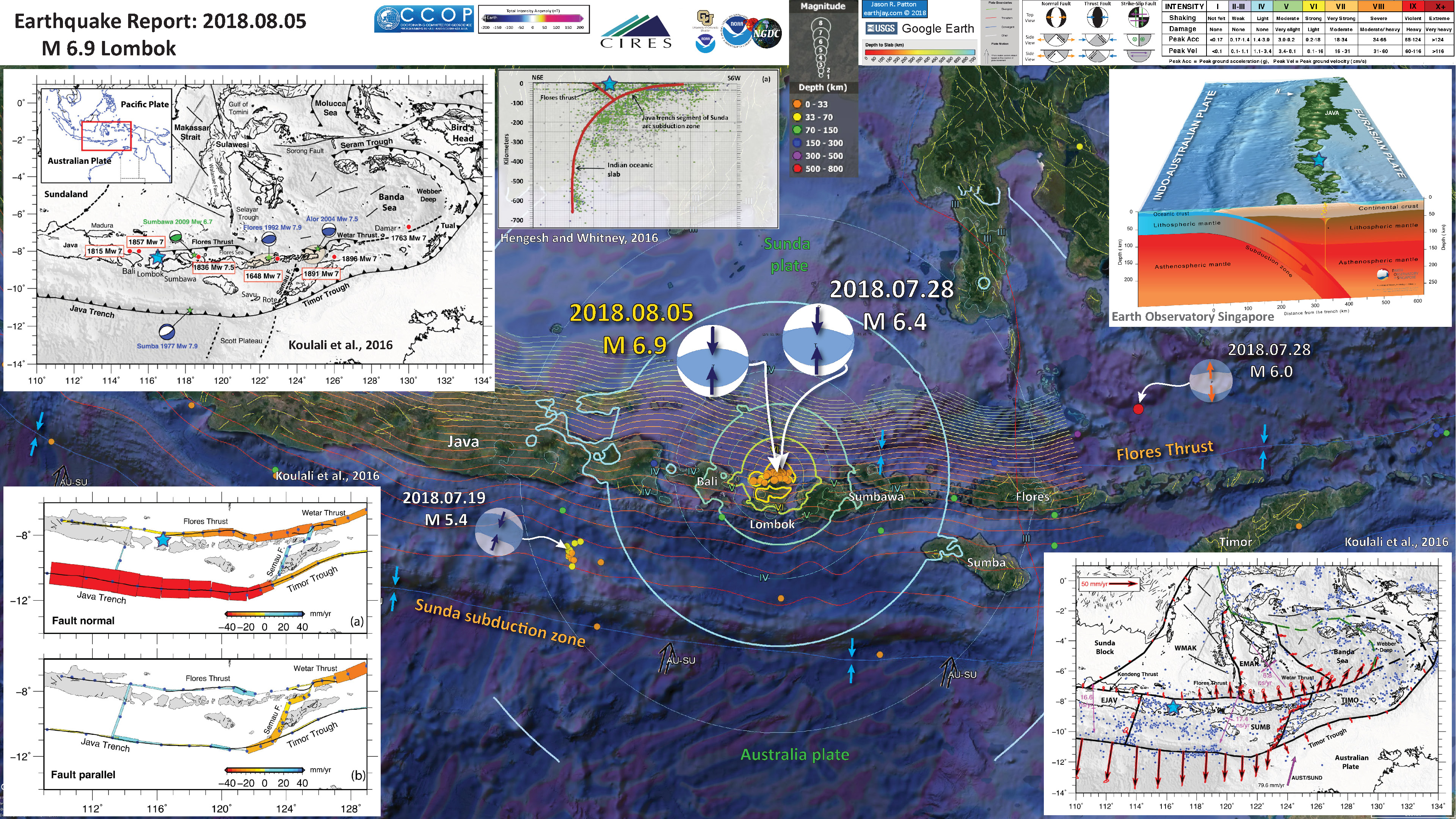

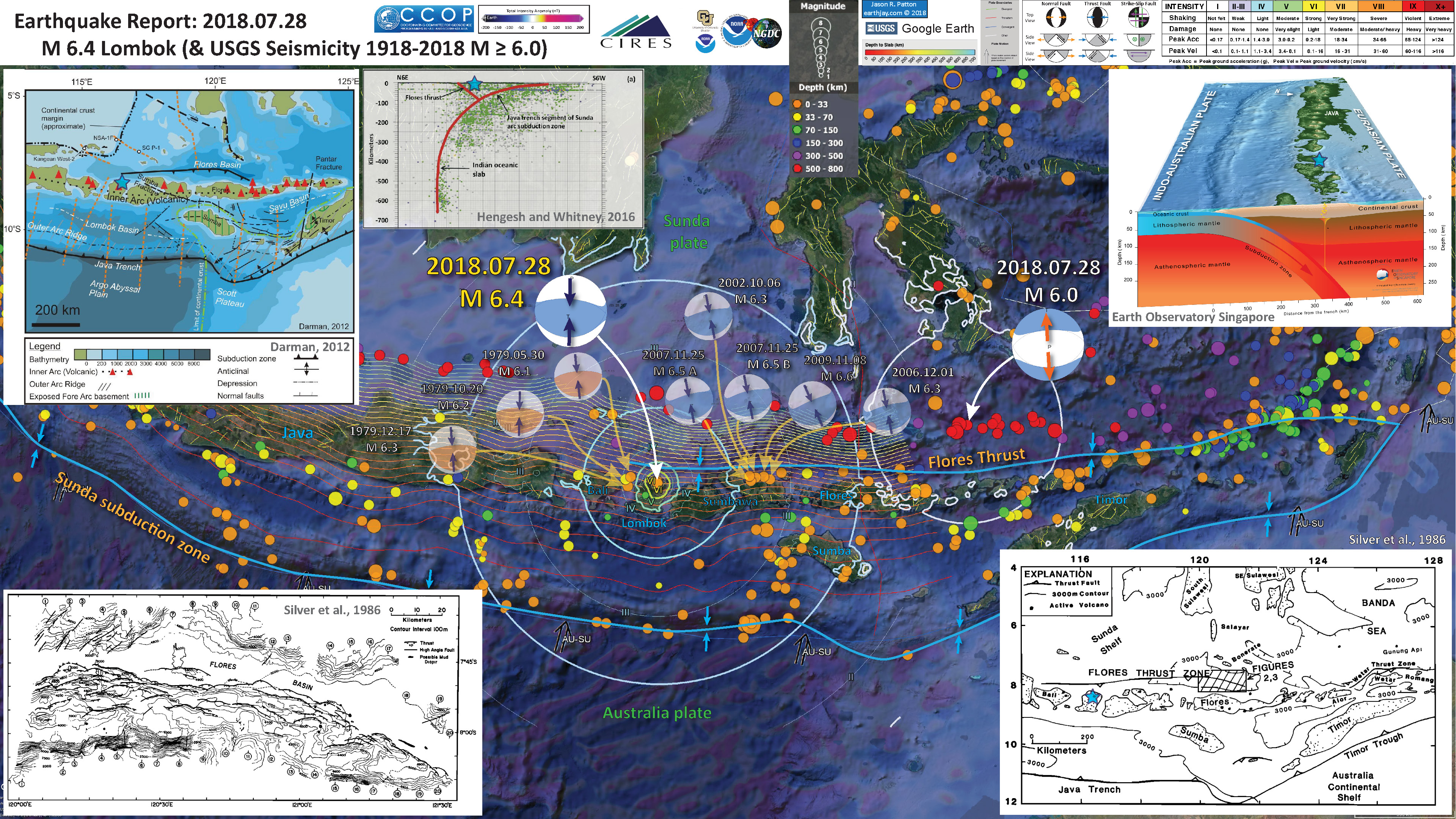
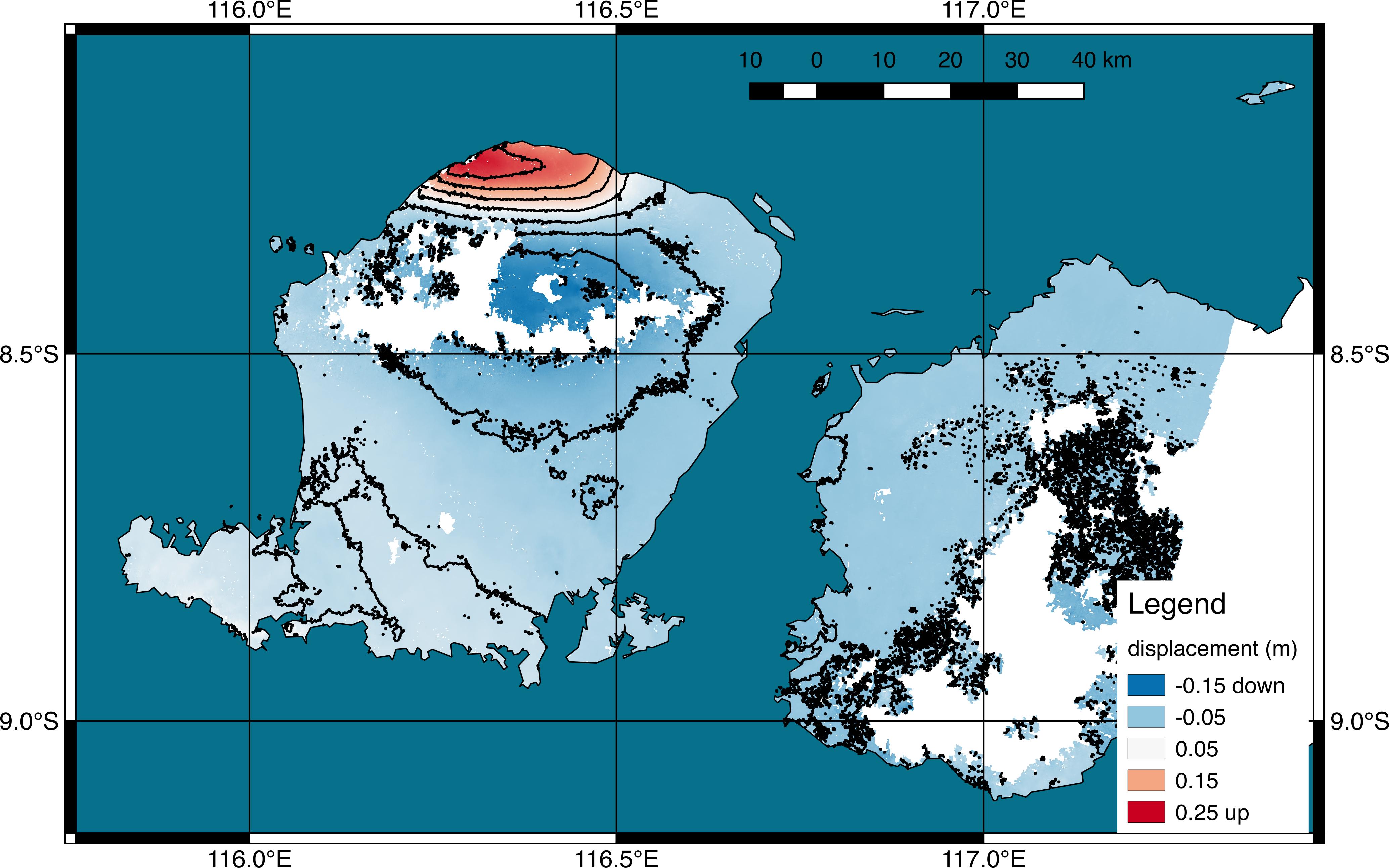


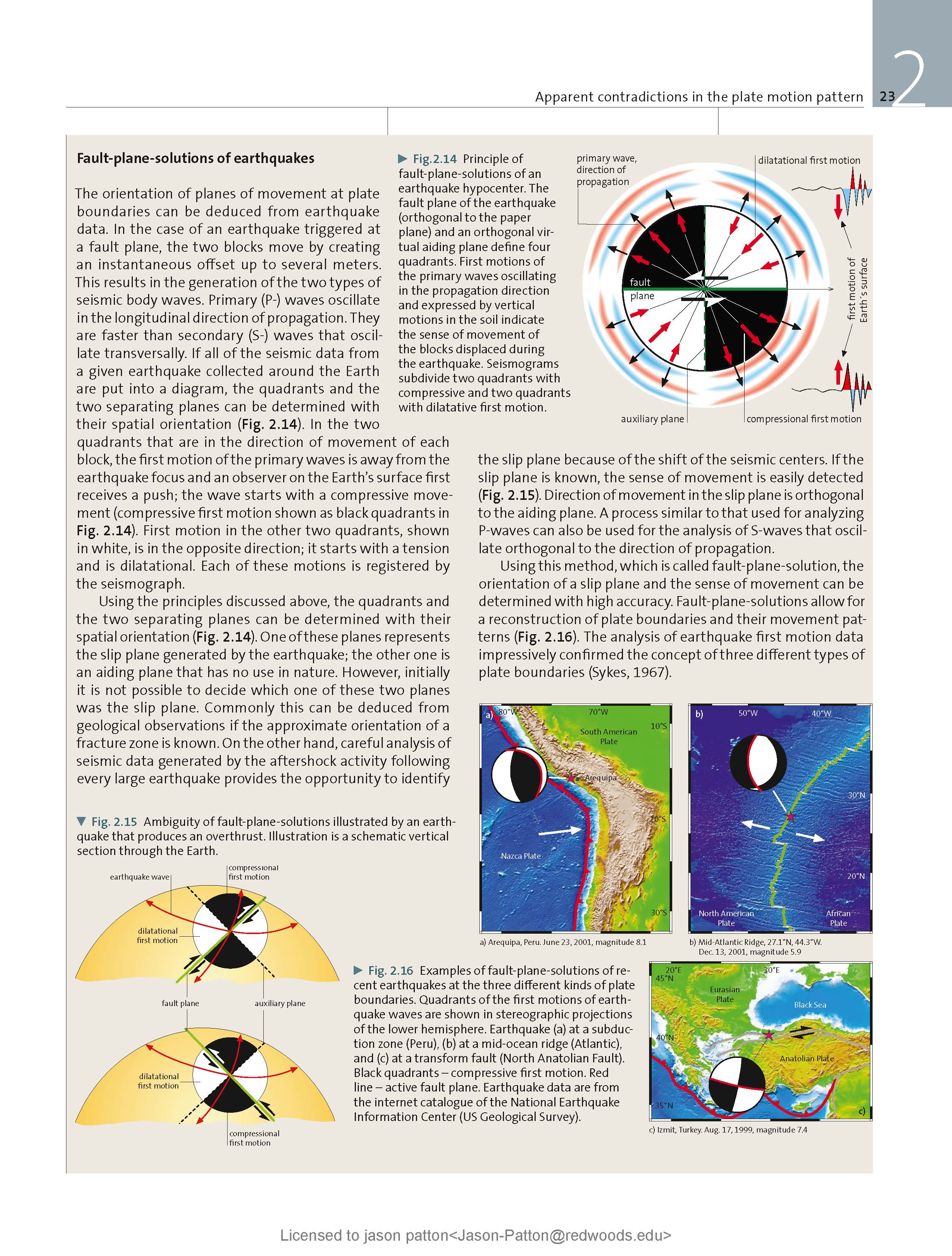
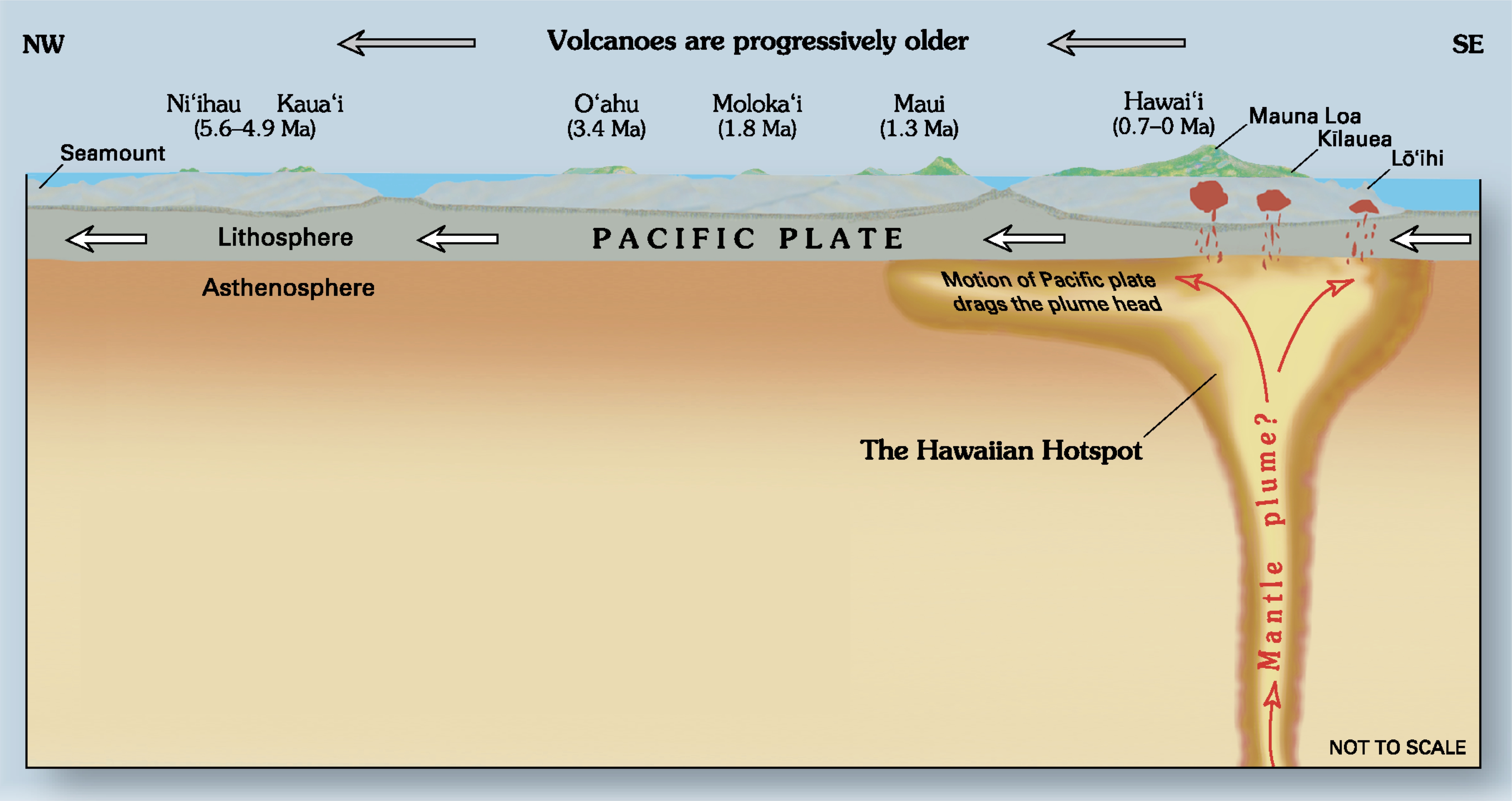
1 thought on “Earthquake Report: Lombok, Indonesia: Update #1”